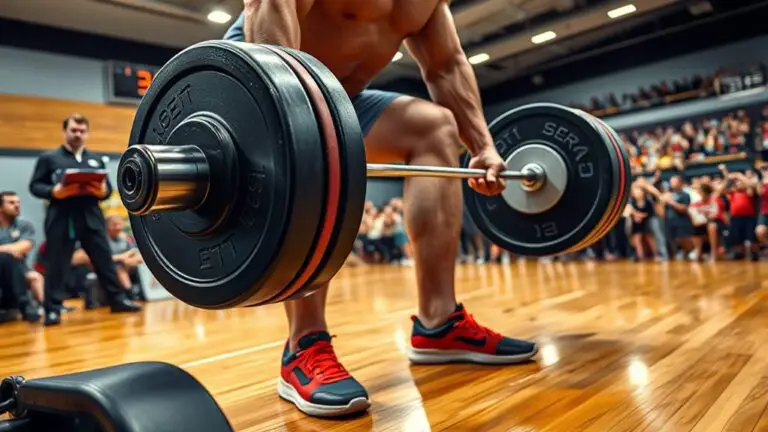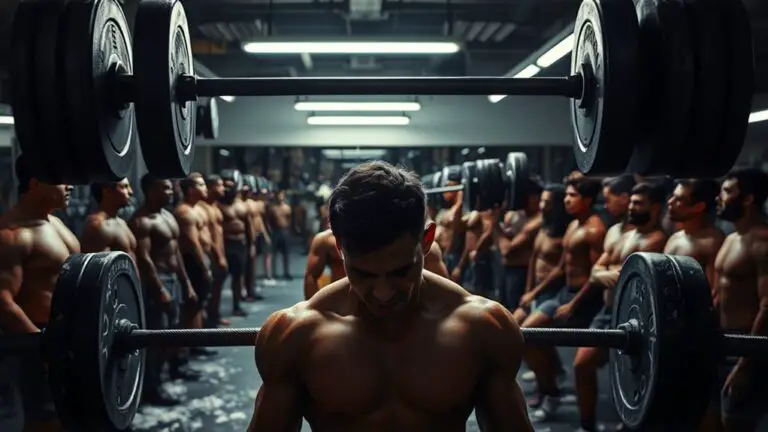How to Train for Your First Powerlifting Meet
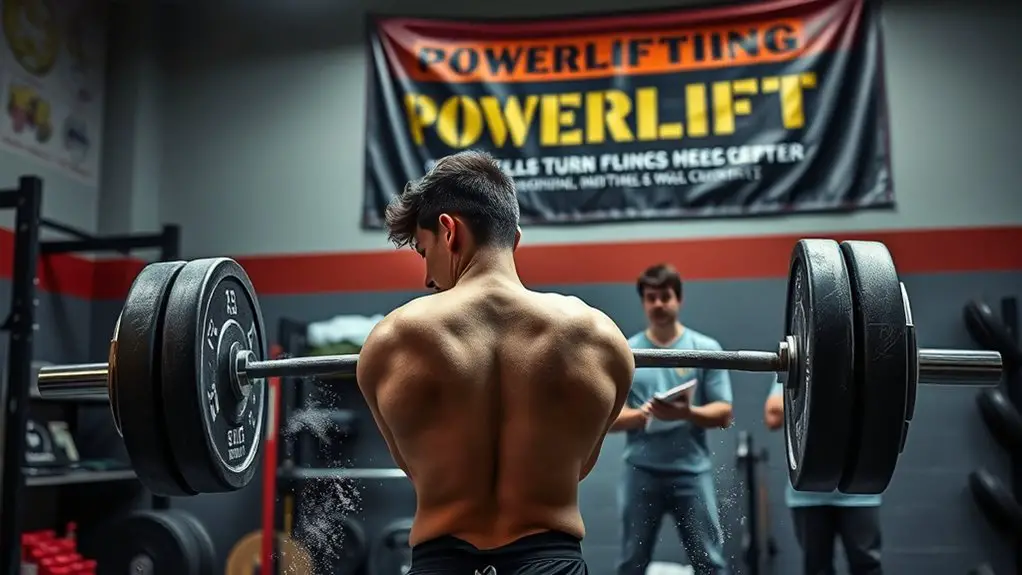
To train for your first powerlifting meet, focus on mastering the squat, bench press, and deadlift. Set realistic goals and craft a training program that balances intensity and recovery. Pay attention to your technique and incorporate accessory movements to build supporting muscles. Prioritize recovery through quality sleep and nutrition, and don’t underestimate the power of mental preparation and visualization. With the right mindset and strategies, you’ll excel on competition day. Discover more tips to enhance your journey towards success.
Understanding the Powerlifting Lifts

When you’re gearing up for your first powerlifting meet, it’s vital to understand the three core lifts: the squat, bench press, and deadlift. Mastering squat mechanics is essential; it involves proper stance, depth, and bar placement to maximize your lift and minimize injury risk. Focus on engaging your core and maintaining a neutral spine throughout the movement.
Moving on to the bench press, make sure your grip is comfortable and your feet are planted firmly for stability. This lift demands precision and control, so practice your setup to optimize your performance.
Lastly, explore deadlift variations like sumo and conventional to find what works best for you. Each variation targets different muscle groups and can help build overall strength. By honing your technique across these lifts, you’ll set a solid foundation for your training and approach your meet with confidence.
Setting Realistic Goals
Setting realistic goals is essential for your success in powerlifting, especially as a newcomer. When you’re starting out, it’s vital to focus on goal setting that aligns with your current abilities and training experience. Instead of aiming for lofty numbers right away, establish incremental goals that are achievable. This could mean improving your form, increasing your lifting weight gradually, or mastering the competition lifts.
Realistic expectations help you avoid frustration and burnout. Track your progress regularly, and celebrate small victories along the way, as these will build your confidence and motivation. Remember, powerlifting is a marathon, not a sprint; patience is key.
Crafting a Training Program
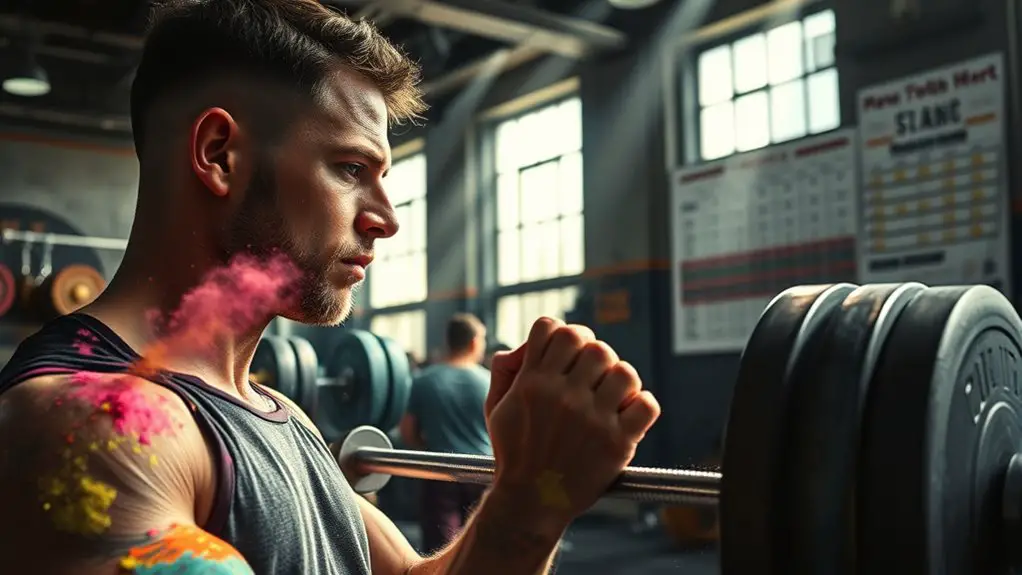
When crafting your training program, you’ll want to start by establishing clear training goals that align with your performance aspirations. Next, structuring your weekly workouts effectively will help you balance intensity and recovery, ensuring you’re prepared for the competition. Let’s break down how to create a plan that sets you up for success.
Establishing Training Goals
As you prepare for your first powerlifting meet, establishing clear training goals is essential for guiding your progress and keeping you motivated. By aligning your goals with your performance, you’ll create a roadmap for success. Here are some tips to help you set effective training goals:
- Define specific weight targets for each lift
- Set a timeline for achieving these goals
- Incorporate a mix of short-term and long-term objectives
- Regularly assess your progress through performance tracking
- Adjust your goals based on training feedback and results
With these strategies, you’ll guarantee that your training is focused and purposeful, leading to improved strength and confidence as you approach your meet. Remember, goal alignment is key to staying on track!
Structuring Weekly Workouts
To effectively prepare for your first powerlifting meet, structuring your weekly workouts is essential, as it guarantees a balanced approach to training that targets all the key lifts. Start by implementing weekly periodization, which allows you to alternate between intensity and volume throughout the week. This method helps prevent burnout and promotes recovery.
Incorporate workout variation by changing up your exercises, rep ranges, and tempos. For instance, dedicate one day to heavy squats, another to bench press, and a third to deadlifts. Don’t forget to include accessory movements to strengthen supporting muscles.
This balanced structure not only enhances performance but also keeps your training engaging, ensuring you stay motivated as you prepare for the competition.
Focusing on Technique
When it comes to powerlifting, mastering the basics is essential for your success. Focus on perfecting your technique during squats, bench presses, and deadlifts, as even small adjustments can lead to big improvements. Consider using video analysis to capture your form and identify areas for enhancement, ensuring you’re ready for the competition.
Mastering the Basics
While mastering the basics of powerlifting, focusing on technique is essential for both safety and performance. Proper lifting mechanics form the foundation of powerlifting fundamentals, ensuring you can lift effectively and prevent injury. Here are some key points to keep in mind:
- Stance and Grip: Find the ideal position for your body and hands.
- Breathing Technique: Use proper breathing to stabilize your core.
- Bar Path: Keep the bar close to your body for efficient lifting.
- Joint Alignment: Maintain proper alignment to prevent strain.
- Controlled Movement: Avoid jerky motions; focus on smooth, controlled lifts.
Video Analysis Techniques
How can you guarantee your technique is on point before your first powerlifting meet? Utilizing video analysis techniques is essential. By recording your sessions, you can conduct lift analysis for effective performance feedback. A detailed technique breakdown helps you identify areas needing form correction.
Here’s a simple table to help guide your video analysis:
| Technique Focus | Action Steps |
|---|---|
| Video Review | Record and review lifts |
| Athlete Comparison | Compare against elite lifters |
| Progress Tracking | Log improvements over time |
Incorporating Accessory Work
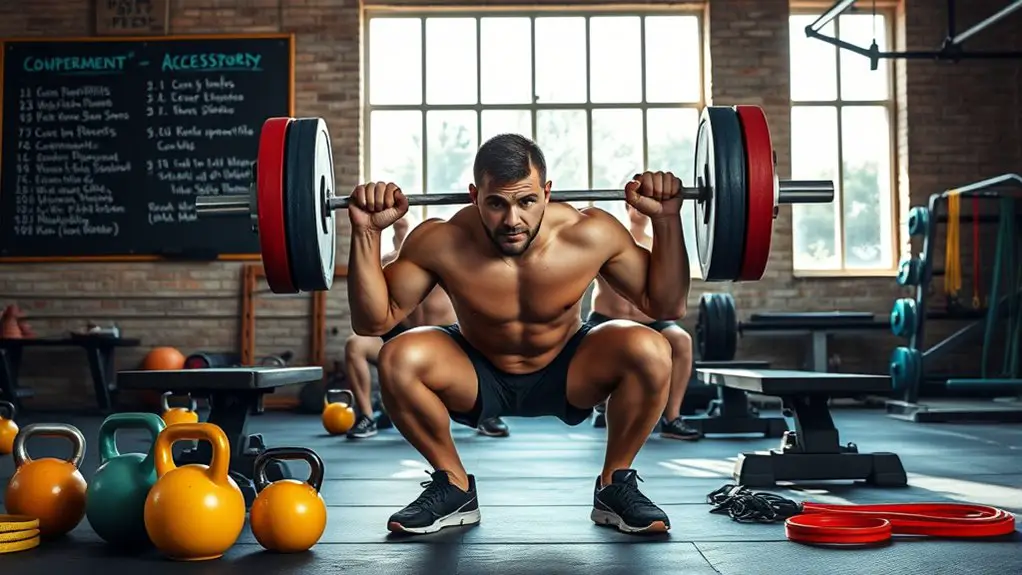
Incorporating accessory work into your training routine is essential for enhancing your overall performance in powerlifting. These accessory exercises help target specific muscle groups, improve weaknesses, and support your main lifts. Remember, it’s not just about lifting heavy weights; mobility work is vital for maintaining joint health and preventing injuries.
Here are some effective accessory exercises to take into account:
- Pull-ups or Lat Pulldowns: Strengthen your back for a stronger deadlift and squat.
- Dumbbell Rows: Improve upper body stability and muscle balance.
- Leg Curls: Enhance hamstring strength, vital for squats and deadlifts.
- Glute Bridges: Activate and strengthen your glutes, aiding hip power.
- Core Work: Planks or hanging leg raises can boost your overall stability.
Integrating these exercises into your regimen will not only help you lift more but also build a well-rounded physique.
Prioritizing Recovery
As you push your limits in training for your first powerlifting meet, prioritizing recovery becomes essential to your success. Good recovery can enhance performance and prevent injury. Start by focusing on sleep hygiene; aim for 7-9 hours of quality sleep each night. Create a bedtime routine that promotes relaxation, such as limiting screen time and maintaining a cool, dark sleep environment.
Next, pay attention to nutrition timing. Consuming protein and carbohydrates soon after training helps replenish glycogen stores and repair muscle tissue. Plan your meals around workouts to maximize recovery benefits. Incorporate rest days into your training schedule, allowing your body to heal and adapt to the stresses of lifting.
Lastly, consider active recovery techniques like light cardio or mobility work to facilitate blood flow and reduce soreness. By prioritizing recovery, you’ll guarantee that you’re fully prepared and energized for your powerlifting meet.
Mental Preparation and Visualization
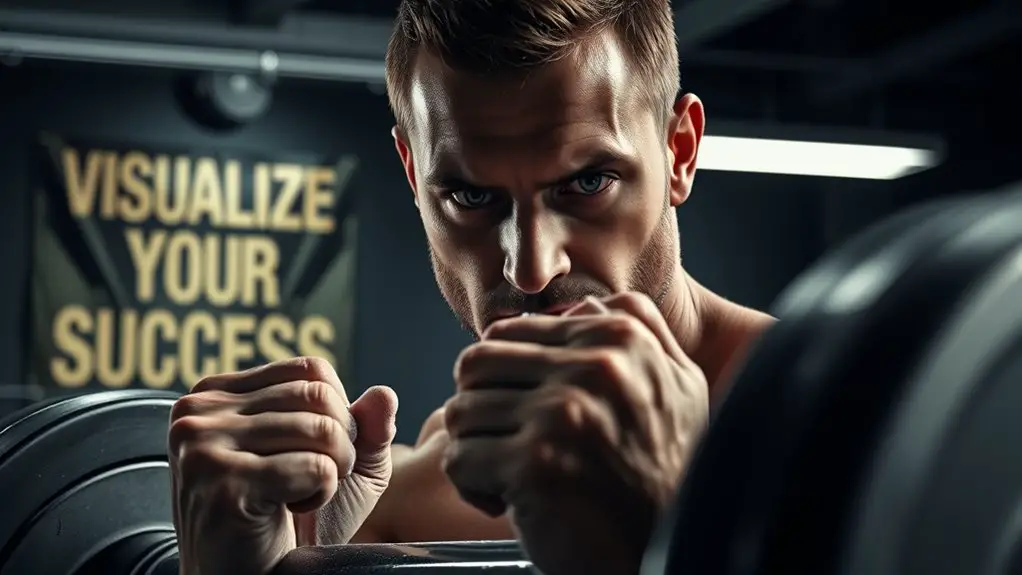
Recovery isn’t just about physical rest; mental preparation plays a significant role in your success at a powerlifting meet. By focusing on mental imagery and confidence building, you can enhance your performance and tackle any challenges that come your way.
- Visualize successful lifts to create a positive mental space.
- Use affirmations to boost your confidence before the meet.
- Practice mindfulness techniques to stay calm under pressure.
- Set clear mental goals to keep your focus sharp.
- Develop a pre-lift routine to create consistency and reduce anxiety.
Engaging in these practices will help you create a strong mindset. Picture yourself executing each lift perfectly, feeling the weight in your hands, and experiencing the exhilaration of accomplishment. By incorporating mental imagery into your training, you not only build confidence but also prepare yourself to perform at your best when it counts. Your mind is as powerful as your body; don’t underestimate its importance.
Competition Day Strategies
Although you’ve put in the hard work leading up to your first powerlifting meet, competition day brings its own set of challenges that can impact your performance. Start your day with effective weigh-in strategies. Make certain you’re aware of the weigh-in time and plan your meals accordingly to guarantee you hit your weight class without compromising energy levels.
Once you’ve weighed in, focus on your warm-up routines. These should mimic your competition lifts but at lower intensities. Gradually increase the weight while paying attention to form. This not only prepares your muscles but also helps you mentally shift into competition mode.
Stay hydrated and fuel your body with easy-to-digest snacks, keeping energy levels high. Finally, remember to stay calm and focused. Trust in your training, and visualize your lifts as you approach the platform. With the right strategies, you’ll set yourself up for a successful meet!
Frequently Asked Questions
What Equipment Do I Need for My First Powerlifting Meet?
Did you know over 80% of lifters benefit from proper footwear? For your first meet, you’ll need lifting shoes for stability, chalk for grip, and a belt for support. Don’t forget a singlet, too!
How Do I Choose the Right Weight Class for Competition?
Choosing your weight class involves body weight adjustments and considering your training goals. Think about your current weight, potential for growth, and how comfortable you feel competing in a specific category to maximize your performance.
Can I Use Wraps or Belts During My First Meet?
Yes, you can use wraps and belts during your first meet. Wraps provide joint support, enhancing stability, while belts help with core engagement, boosting lifting power. Just make sure you’re familiar with their use beforehand for maximum performance.
What Should I Eat Before and During the Competition?
Imagine fueling a race car: you wouldn’t skimp on gas. For pre-meet nutrition, focus on complex carbs and proteins, then pack performance snacks like bananas or energy bars to keep your energy steady during the competition.
How Do I Handle Nerves on Competition Day?
On competition day, you can handle nerves by practicing visualization techniques, imagining successful lifts. Combine this with deep breathing exercises to calm your mind and body, helping you focus and perform at your best.
